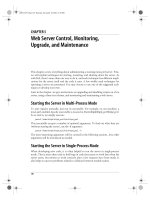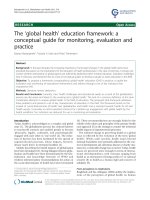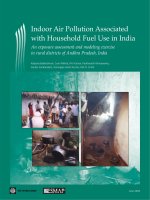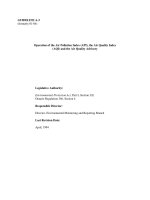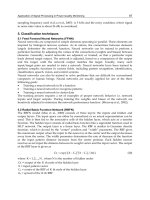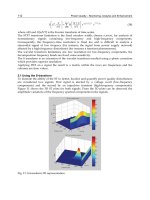AIR QUALITY MONITORING, ASSESSMENT AND MANAGEMENT_1 doc
Bạn đang xem bản rút gọn của tài liệu. Xem và tải ngay bản đầy đủ của tài liệu tại đây (18.04 MB, 86 trang )
AIRQUALITY
MONITORING,
ASSESSMENTAND
MANAGEMENT
EditedbyNicolásA.Mazzeo
Air Quality Monitoring, Assessment and Management
Edited by Nicolás A. Mazzeo
Published by InTech
Janeza Trdine 9, 51000 Rijeka, Croatia
Copyright © 2011 InTech
All chapters are Open Access articles distributed under the Creative Commons
Non Commercial Share Alike Attribution 3.0 license, which permits to copy,
distribute, transmit, and adapt the work in any medium, so long as the original
work is properly cited. After this work has been published by InTech, authors
have the right to republish it, in whole or part, in any publication of which they
are the author, and to make other personal use of the work. Any republication,
referencing or personal use of the work must explicitly identify the original source.
Statements and opinions expressed in the chapters are these of the individual contributors
and not necessarily those of the editors or publisher. No responsibility is accepted
for the accuracy of information contained in the published articles. The publisher
assumes no responsibility for any damage or injury to persons or property arising out
of the use of any materials, instructions, methods or ideas contained in the book.
Publishing Process Manager Natalia Reinic
Technical Editor Teodora Smiljanic
Cover Designer Jan Hyrat
Image Copyright Jeff Banke, 2010. Used under license from Shutterstock.com
First published June, 2011
Printed in Croatia
A free online edition of this book is available at www.intechopen.com
Additional hard copies can be obtained from
Air Quality Monitoring, Assessment and Management, Edited by Nicolás A. Mazzeo
p. cm.
ISBN 978-953-307-317-0
free online editions of InTech
Books and Journals can be found at
www.intechopen.com
Contents
Preface IX
Part 1 Air Quality Monitoring 1
Chapter 1 Planning Air Pollution Monitoring
Networks in Industrial Areas by Means
of Remote Sensed Images and GIS Techniques 3
Mauro Rotatori, Rosamaria Salvatori and Roberto Salzano
Chapter 2 Design of Urban Air Quality Monitoring Network:
Fuzzy Based Multi-Criteria Decision Making Approach 25
Abdullah Mofarrah, Tahir Husain and Badr H. Alharbi
Chapter 3 Malodor Detection Based on Electronic Nose 41
Teerakiat Kerdcharoen,
Chatchawal Wongchoosuk and Panida Lorwongtragool
Part 2 Air Quality Assessment and Management 75
Chapter 4 “Nuisance Dusts” – Validation and Application
of a Novel Dry Deposition Method for Total Dust Fall 77
Gary T. Hunt
Chapter 5 Characterization of Particles Transmitted by
Wind from Waste Dump of Phosphatic Fertilizers
Plant Deposited on Biological Sample Surfaces 93
M.I. Szynkowska, A. Pawlaczyk and J. Rogowski
Chapter 6 Role of the Ionic Component and Carbon
Fractions in the Fine and Coarse Fractions of
Particulate Matter for the Identification of
Pollution Sources: Application of Receptor Models 109
Pierina Ielpo, Claudia Marcella Placentino, Isabella Cafagna,
Gianluigi de Gennaro, Martino Amodio,
Barbara Elisabetta Daresta and Alessia Di Gilio
VI Contents
Chapter 7 Monitoring and Reporting VOCs in Ambient Air 137
Anjali Srivastava and Dipanjali Majumdar
Chapter 8 Estimated Atmospheric
Emissions from Mobile Sources and
Assessment of Air Quality in an Urban Area 149
Elba Calesso Teixeira, Camila D. P. Mattiuzi,
Flavio Wiegand, Sabrina Feltes and Felipe Norte
Chapter 9 Applications of Remote Sensing
Instruments in Air Quality Monitoring 173
Chuen Meei Gan, Barry Gross, Yong Hua Wu and Fred Moshary
Chapter 10 The Surveillance of the
Air Quality in the Vicinity of an Active
Volcano: Case of the Piton de la Fournaise 205
Chatrapatty Bhugwant, Miloud Bessafi and Bruno Siéja
Chapter 11 Remote Zones Air Quality - Persistent
Organic Pollutants: Sources, Sampling and Analysis 223
Alessandro Bacaloni, Susanna Insogna and Lelio Zoccolillo
Chapter 12 Asian Dust Storm as a Natural Source of Air
Pollution in East Asia; its Nature, Aging, and Extinction 241
Chang-Jin Ma
Chapter 13 Genetic Biomarkers Applied to Environmental
Air Quality: Ecological and Human Health Aspects 267
Vera Maria Ferrão Vargas,
Kelly Cristina Tagliari de Brito and Mariana Vieira Coronas
Chapter 14 An Evaluation of Atmospheric
Aerosols in Kanana, Klerksdorp Gold
Mining Town, North-West Province of South Africa 285
Brighton Kaonga and Eno E. Ebenso
Chapter 15 Some Guidelines to Improve
Air Quality Management in Santiago, Chile:
From Commune to Basin Level 305
Margarita Préndez, Gerardo Alvarado and Italo Serey
Chapter 16 Multi-Year Assessment of Airborne Metals
in Fallon, Nevada, using Leaf-Surface Chemistry 329
Paul R. Sheppard, Gary Ridenour and Mark L. Witten
Chapter 17 Organic Compounds in Airborne Particles
and their Genotoxic Effects in Mexico City 345
Villalobos-Pietrini R., Amador-Muñoz O., Valle-Hernández B.L.,
Gómez-Arroyo S., Waliszewski S. and Jazcilevich A.D.
Preface
Human beings need to breathe oxygen diluted in certain quantity of inert gas for
living. In the atmosphere, there is a gas mixture of, mainly, oxygen and nitrogen, in
appropriate proportions. However, the air also contains other gases, vapours and
aerosols that humans incorporate when breathing and whose composition and
concentration vary spatially
. Some of these are physiologically inert. An unpolluted
atmosphere never existed. From the very beginning of time, the decomposition of
vegetable, animal matter and the forest fires have emitted gases and particles.
However,asaconsequenceoftechnologicaldevelopment,airpollution hasbecomea
problemofmajor concernin thelastfewde
cades,sinceithascausednegativeeffects
onhumanhealth,natureandproperties.
This book presents the results of research studies carried out by researchers from
different countries, presented in seventeen chapters which can be grouped into two
main sections. Those sections are: a) air quality monitoring and b) air quality
assessment and management. Most chapters are the result of research work done by
theirauthorsduringseveralyears.
The first three chapters, which form the first section, have been prepared by
researchersfromItaly,Canada‐SaudiArabiaandThailand.Thesechaptersarefocused
on the discussion about the d
ifficulties of the air quality network design and on the
development and description of theapplication of anelectronic nosetodetect odour
generatedbydifferentairpollutants.
The second section is consti tuted of fourteen chapters and focu ses on air quali ty
assessmentand ma nagement in different areas.The authorsof these chaptersar
e fr om
USA (three chapters),Poland, Italy(t wochapters),Brazil(t wochapters), India,Fra nce,
Japan, South Afric a, Chile and Mexico. Chapter 4 deals with a monitoring program of
total particulate deposition in the vicinity of the coal fired power plant employing
passive dry depo sition techniques. Chapter 5 investigates the possible occurrence of
dustingprocessbyanalyzingtheatmosphericparticulatesaccumulatedonthebiological
surface and compares them with the particles characteristic of phosphogypsum waste
by‐product. Chapter 6 presents an ap plication of Principal Component Analysis and
Absolute Principal Component Scores to the data set of chemical parameters (ions,
organiccarbonandelementalcarbon)ofPM2.5andPM10data obtainedwithsampler.
X Preface
Chapter7isareviewarticleondifferenttechniquesof measurementandmonitoringof
VOCs in emission gases and air quality. Chapter 8 describes the estimation of vehicle
emissions of CO, NOx, HC, SO2 and PM in an urban area located in Brazil, from the
additionofbiodieseltodieselandev
aluatesair qualityaccordingtoPM, CO,NOx, O3,
SO2, PAHs, NPA Hs and meteorological variables. Thischapter illustrates why vertical
information is critical in monitoring air quality and how large ‐scale plume
transportation affects surface pollution level. Chapter 9 outlin es the importance of
remote sensing inst ruments in mu ltiple applications in monitoring the ve
rtical
distribution of air quality and dem onstrates how they can unravel difficulties in air
quality retrieval from satellite techniques. Ch apter 10 presents SO2 concentration
measurementsundertakenoveranislandandinthevicinityofavolcanoduringandoff
eruption events. Chapter 11 deals with different sampling and analysis t
echniques for
persistent organic pollutants in the atmosphere of remote zones. In chapter 12, the
specialinformati o non Asiandust–stormparticleswhichisapeculiarnaturalsourceof
airpollutioninEastAsiaandthePacificOceanisreported.Chapter13addressestheuse
of genetic damage biomarkers as early indicators for mai
nly organ ic atmospheric
pollution,comparesthemutagenicresponses withparticulate matterconcentrationand
discussesthebi ologicaleffects observedinassaysusingsamplesof differentparticulat e
matter size. Chapter 14 gives the results of an evaluation of atmospheric aerosols in a
gold mi ning town. The main objective of chapter 15 is to id
enti fy the causes of high
levelsofPM10 concentrationsinthe M e tropolita nRe gionof thecityof Santiago (Chile)
inorderto contributeto improv ethema nagementofairquality inthecity.Ch apter16
describes a multi‐year assessm ent of airborne metals, using leaf‐surface chemistry.
Chapter 17 pre
sents a study of the organic compounds in airborne particles and their
impact onclimateand airquality,chem icalc ompositionandsourceap po rt ionment, as
well as on instr umenta l determination and atmosp heric transformation, besides their
toxiceffectsandtoriskhumanhealth.
Thisbookprovidesasourceofmaterialforallthoseinvo
lvedinthefield,whetheras a
student, scientific researcher, industrialist, consultant, or government agency with
responsibilityinthisarea.
It should be emphasized that all chapters have been prepared by profe ssionals who
areexpertsintheirresearchfields.Thecontentofeachchapterexpressesthepointof
view of its aut
hors who are responsible for its development. All chapters have been
submitted to reviews in order to improve their presentation following several
interactions between the Editor‐Publisher‐Authors. In this sense, the Editor, the
Publisherandhard‐workingairqualityprofessionalshaveworkedtogetherasateam
toprepare abookthatmaybecomeareference inthefieldnext years.Thiswill have
beenachieved,mainly,thankstothegroupofexpertsintheirresearchfieldsjoinedas
authorsofthisbook.
NicolásA.Mazzeo
NationalScientificandTechnologicalResearchCouncil
NationalTechnologicalUniversity
Argentina
Part 1
Air Quality Monitoring
1
Planning Air Pollution Monitoring
Networks in Industrial Areas by Means of
Remote Sensed Images and GIS Techniques
Mauro Rotatori, Rosamaria Salvatori and Roberto Salzano
National Research Council of Italy - Institute of Atmospheric Pollution Research
Italy
1. Introduction
Air pollution and its impact have become one of the most important challenge for public
authorities. The quantification of emissions as well as their spatial distribution are essential
for any air quality program (Aleksandropoulou & Lazaridis, 2004; Sengupta et al., 1996).
The selection of the location of monitoring stations is one of the most complex task that
occurs in designing air monitoring networks. Several issues, as the harmful effects of
pollution on both human health and environment, must be taken into account (Allegrini et
al., 2004).
The European directive 2008/50/CE of 21 May 2008 on ambient air quality and cleaner air
provides criteria about monitoring network. This directive has been issued in order to
improve, clarify, simplify and replace the precedents five acts:
• Council Directive 96/62/EC of 27 September 1996 on ambient air quality assessment
and management;
• Council Directive 1999/30/EC of 22 April 1999 relating to limit values for sulphur
dioxide, nitrogen dioxide and nitrogen oxides, particulate matter and lead in ambient
air;
• Directive 2000/69/EC of the European Parliament and of the Council of 16 November
2000 relating to limit values for benzene and carbon monoxide in ambient air;
• Directive 2002/3/EC of the European Parliament and of the Council of 12 February
2002 relating to ozone in ambient air and;
• Council Decision 97/101/EC of 27 January 1997 establishing a reciprocal exchange of
information and data from networks and individual stations measuring ambient air
pollution within the Member States.
The Directive 2008/50/CE also introduces new air quality objectives and monitoring
requirements for PM
2.5
. In addition to that the EU directive determines criteria for
positioning monitoring stations, taking into account a detailed evaluation of environmental
features on both local and regional scale.
These objectives can be pursued by territorial analysis, which can be performed using a
Geographic Information System (GIS). GIS is a computer-based information system that
enables storing, modelling, manipulation, retrieval, analysis and presentation of
geographically referenced data (Burrough, 2001). In particular this powerful tool allows a
Air Quality Monitoring, Assessment and Management
4
detailed representation of the investigated territory. Different types of data can be integrated
and correlated: chemical, physical, demographic and any kind of environmental
information. Numeric records can be stored in a GIS, creating and developing a geo-
database. All these information can be analysed and elaborated in order to derive thematic
cartography. GIS gives the opportunity to integrate these thematic layers with health data
and permit the evaluation of health risk towards pollution (Stedman et al., 1997). The
dynamics of these processes can be moreover investigated and monitored over a long period
by multitemporal integration. This last procedure consists on join up of data provided by
different campaigns carried out in the same study area. The background knowledge of every
territorial analysis and successive integration with atmospheric data is made up of satellite
imagery retrieving and classification. This final step provides land use maps and can be
derived with several classification techniques on satellite images or digital aerial imagery
(Foody, 2000; Weirs et al., 2004). The integration of land use maps with concentration maps
of pollutants, allows recognition of areas exposed to high pollution levels and the relative
exposure during time. The successive step of this territorial analysis allows identification of
sites optimal for the installation of monitoring stations following the rules provided by the
directives in force. This chapter proposes a combined procedure between data concerning
pollutants contents and thematic cartography. This approach can support designing of
monitoring networks focused on air quality.
2. Sampling strategies
Campaigns for monitoring pollutants must be planned considering objectives of the survey
and features of the investigated process. These two issues are decisive for the selection of the
season and the extent of the sampling length and are critical for the choice of the passive
samplers location strategy. The passive sampler system, developed by the CNR Institute of
Atmospheric Pollution Research, is particularly useful for preliminary evaluations of air
quality condition (Bertoni 2000; De Santis et al., 1997). Samplers can in factbe exposed for
many months in selected areas of interest, and resulting concentration levels are averaged
over a long period. Passive samplers use active carbon as adsorption phase, active carbon is
contained in a stainless steel netting inserted in the diffusive cylindrical body. Pollutants
adsorbed by active carbon are successively extracted, by solvents or by heating, and
analysed with appropriate chemical techniques. Passive samplers are inserted with the open
side facing to the holder, which is necessary in order to minimize wind interference.
Samplers are then exposed to air for a period long enough to obtain a significant and
adequate sample for the analysis. The selection of the exposure length for sampling is
regulated mainly by the survey objectives: the impact evaluation of new industrial plants on
the environment requires pre-, sin- and post start-up campaigns; the impact evaluation of
existing industrial plants requires, instead, to plan campaigns representative of each season
in order to estimate all climatic and environmental features of the investigated area. The
design of monitoring networks in urban areas requires, as above, the execution of
campaigns representative of all the features characterising the examined urban area. On the
other hand, the scheduling of campaigns and the exposure time of samplers are obviously
influenced dominantly by requirements and funds dedicated by the administrations that
dispose the study. For sure, a longer exposition of passive samplers can, in accordance of
observed concentrations, be more representative of the study area, as the climatic and
environmental conditions are averaged.
Planning Air Pollution MonitoringNetworks in Industrial
Areas by Means of Remote Sensed Images and GIS Techniques
5
Fig. 1. Example of sampling strategy carried out in Urumqi (China, PRC).
The sampling strategy (Fig. 1) must be selected considering the objectives of the survey
(Isaaks & Srivastava, 1989). Strategies can be classified into two major groups: simple and
stratified. The first one is characterised by a single sampling grid. The lattice that localizes
sampling sites is defined by several features: orientation; order; density. Orientation is the
property that defines the alignment of grids with preferential directions of pollutant
dispersion. This feature can be selected taking into account the climatic and environmental
conditions of the study area and can be regulated in order to consider dominant wind
directions, topography and urban characteristics in the case of cities. The order grade of the
grid is referred to the distribution of sampling stations in the territory and to the distance
that occurs between sites. This distance can be constant and guarantees an homogeneous
distribution, or it can be random in order to investigate processes at a more detailed spatial
scale. In opposition of that, the random criteria can add clustering problems to the
distribution of sampling stations. Both geometric features, previously discussed, influence
the final characteristic of the sampling grid. The sampling density is a descriptive parameter
that defines the spatial resolution of the lattice and allows evaluation of homogeneity and
spatial significance of data. Stratified strategies are instead the result of the combination
Air Quality Monitoring, Assessment and Management
6
between two or more simple grids. This group is more appropriate for monitoring studies
with a limited number of stations. It provides a dataset relatively independent from the
studied phenomena and at the same time guarantees a good coverage of the study area.
3. Representation of concentration levels of pollutants
The representation of chemical data in a spatial context requires a three step analysis of
concentration levels (Fig. 2).
Fig. 2. Examples of statistical tools useful for the representation of concentration levels of
pollutants [box diagrams (a), variograms (b) and interpolation algorithm (c)].
3.1 Descriptive analysis
This first step consists on the description, with general statistical parameters, of data
obtained during the monitoring campaigns. Different statistic tests are performed (Davis,
1986), in particular to study the statistical distribution of the dataset;variograms are created
to define the spatial dependence of pollutants. All these data treatments are propaedeutic to
the next steps that are focused on the representation sensu strictu.
3.2 Interpolation criteria
The interpolation criteria that can be applied to chemical data provided by diffusive
samplers can be classified into two main groups (Armstrong, 1998): deterministic (inverse
distance weight, nearest neighbour, linear and polynomial regression), and probabilistic
(ordinary and universal kriging). In the first case, the values in the “unknown” sites are
calculated as linear combination between “measured” stations. Probabilistic criteria estimate
instead the “unknown” value using the spatial dependence model that exists between
“measured” sites. Kriging, in particular, requires that the investigated process, and
consequently the measured dataset respects the “normality” and the “stationariness”
hypothesis (Isaaks & Srivastava, 1989). A complex geostatistical treatment is necessary to
support the application of kriging. The core of this probabilistic method consists in the
definition of spatial dependence model. The appropriated model is selected fitting
experimental variograms with theoric functions. The selection of the interpolation method
depends mainly on the sampling strategy and on the number of available samples.
Unfortunately there are no objective criteria that support the selection of the most
appropriate interpolation method. Each case differs from the others and only the
preliminary analysis and the variogram study can help the user to take decisions. It is
Planning Air Pollution MonitoringNetworks in Industrial
Areas by Means of Remote Sensed Images and GIS Techniques
7
possible to evaluate the goodness of resulting maps creating error maps, which can be
calculated as the difference between “measured” and “calculated” values.
Concentration
level
SO
2
O
3
NO
x
NO
2
H
2
S
µg/m
3
1
st
0 – 20.8 0 – 20 0 – 13.3 0 – 13.3 0 – 2.7
2
nd
20.8 – 41.7 20 – 40 13.3 – 26.7 13.3 – 26.7 2.7 – 5.3
3
rd
41.7 – 62.5 40 – 60 26.7 – 40.0 26.7 – 40.0 5.3 – 8
4
th
62.5 – 83.3 60 – 80 40.0 – 53.3 40.0 – 53.3 8 – 10.7
5
th
83.3 – 104.2 80 – 100 53.3 – 66.7 53.3 – 66.7 10.7 – 13.3
6
th
104.2 – 125.0 100 – 120 66.7 – 80.0 66.7 – 80.0 13.3 – 16.0
7
th
> 125.0 > 120 > 80 > 80 > 16.0
Concentration
Level
Benzene
Toluene
Xylenes
VOCs
µg/m
3
1
st
0 – 1.6 0 – 8.3 0 – 8.3 0 – 16.7
2
nd
1.6 – 3.3 8.3 – 16.7 8.3 – 16.7 16 – 33.3
3
rd
3.3 – 5 1.7 – 25.0 1.7 – 25.0 33.3 – 50.0
4
th
5 – 6.6 25.0 – 33.3 25.0 – 33.3 50.0 – 66.7
5
th
6.6 – 8.3 33.3 – 41.7 33.3 – 41.7 66.7 – 83.3
6
th
8.3 – 10.0 41.7 – 50.0 41.7 – 50.0 83.3 – 100.0
7
th
> 10.0 > 50.0 > 50.0 > 100.0
Table 1. Suitable concentration levels of pollutants for distribution maps. Bold numbers
represent the reference values, that are based on annual limits indicated by legislation, when
available.
3.3 Classification of pollution levels
The classification of pollution levels for each considered substance can be arbitrary,
objective or derived. The first criterion can be applied using statistic parameters as
equivalent classes, quartile, standard deviation or whatever the user wants to use for
subdividing the range into levels. The classification with an objective criterion is instead
based on selecting a reference value that can be indicated, for example, by legislation. In
conclusion several derived criteria can be used as calculated indexes. It is possible to
calculate ratios respect reference values or coefficients that consider health effects produced
by specific pollutants (Table 1).
4. Territorial analysis with remote sensed images
The best locations for air quality monitoring stations can be found analysing the
environmental patterns of the region where the network must be located, even if socio-
political reasons cannot be neglected. The study of environmental patterns can be conducted
Air Quality Monitoring, Assessment and Management
8
using coverage and land use maps along with census maps. The availability of updated and
detailed maps is very limited and to overcome this problem it is only possible to derive
these thematic maps by processing remote sensed images. Remote sensors collect and
record the electromagnetic energy coming from the Sun and reflected, or emitted, by the
Earth surface at different wavelengths. For environmental studies the wavelength range
used by sensors (passive optical sensors) is between 450 nm and 2500 nm, although there are
passive sensors that can collect images in the thermal infrared wavelengths range (8000 –
10000 nm). Each surface element like soil, different types of vegetation cover, urban areas,
reflects the electromagnetic energy as a function of its chemical and physical characteristics,
i.e. each surface element shows a different spectral behaviour that can be considered as its
fingerprints or its spectral signatures. Images collected at different wavelength intervals
(different bands) can be processed in order to assign a surface element to each pixel of
images and to analyse the spatial distribution of these elements. At the present time, there
are many remote sensors and each of them can collect images characterised by a different
spectral range (band). The number of bands, their width and their location in the
electromagnetic spectrum define the spectral resolution of the image. Most of the sensors
record the reflected energy in the visible range, with three spectral bands centred on blue,
green and red light, one or more bands are instead reserved for the spectral range that
corresponds to middle and near-infrared and generally only one band is dedicated to
measure the radiation in the thermal infrared. Therefore, a remote sensing (RS) image can be
composed of different number of bands: a multispectral image is represented by 3 - 7 bands
while hyperspectral images can have more the 100 bands, where more than one corresponds
to the thermal infrared. In theory, a higher number of bands can allow a more detailed
analysis of the spectral characteristics of surface element. The availability of images collected
simultaneously at different wavelength ranges, allows selection of the most appropriate set
of bands useful for the specific investigation. Visible and near infrared images are, for
instance, used mainly for vegetation and land cover studies while images recorded at higher
wavelengths are more useful for geological applications. Moreover, images recorded in the
thermal infrared can be processed in order to derive radiant temperature of the surfaces.
Remote sensors used for environmental investigation can be carried aboard on satellites or
aircrafts. In the first case, the geometry of the sun-target-sensor system, is determined by
orbital parameters. The resultant image has consequently a fixed and constant pixel size.
Aircrafts can, instead, fly at specified altitude that can be selected in order to achieve the
requested spatial resolution. These images can also be collected at different day time
improving the discrimination of surface elements. Nowadays, the improvement of spatial
technologies makes available a wide selection of satellite images with a “spatial resolution”
ranging between 1km and few metres and a “pass over” time ranging between 0.5 and 25
days. Sensors with low spatial resolution pass over the same area daily while sensors with
medium or high resolution have pass over time of 3 - 16 days (Table 2).
Such a wide availability of remote sensed images with different spatial and spectral
characteristics makes possible the production of thematic maps with a higher level of
accuracy and with a scale controlled by the image pixel size. The selection of the most
appropriate sensor must be carried out before the information extraction process and must
take into account the purposes of the study averaging out between spatial and spectral
resolutions. For instance, the most suitable data sets for regional scale studies are the
Landsat Thematic Mapper images. Such sensor acquires images with 7 spectral bands, in the
Planning Air Pollution MonitoringNetworks in Industrial
Areas by Means of Remote Sensed Images and GIS Techniques
9
wavelength range between visible and thermal infrared, at ground resolution of 30m per
pixel (Table 2). These radiometric and geometrical characteristics allow the investigation of
large areas with a spectral resolution suitable for the production of land cover or land use
maps with a scale ranging between 1:50.000 and 1:100.000. Image fusion techniques, that
combine images with different spatial and spectral resolutions, are a very useful tool to
preserve the highest content of information. Moreover, all the other multispectral
instruments devoted to Earth observations, as Thematic Mapper, were designed taking into
account the spectral properties of natural surfaces. Vegetation cover patterns can be easily
discriminated by processing red and near infrared bands (TM3, TM4, TM5) while
differences between soils moisture or rock outcrops can be detected using band TM5 and
TM7. The complexity of the information embedded in multispectral images is the key that
allows, using proper statistical classification algorithms, the elaboration of thematic maps
for environmental applications.
NOAA
AVHRR
Landsat 7
ETMP
SPOT5
HRVIR
IRS
LISS-I
IKONOS QuickBird
Image
bands
(µm)
0.58 – 0.68 0.45 – 0.52
a
0.45 – 0.52
a
0.45 – 0.52
a
0.725 – 1.1 0.52 – 0.60
a
0.50 – 0.59
a
0.52 – 0.59
a
0.52 – 0.61
a
0.52 – 0.60
a
3.55 – 3.93 0.63 – 0.69
a
0.61 – 0.68
a
0.62 – 0.68
a
0.64 – 0.71
a
0.63 – 0.69
a
10.3 – 11.3 0.76 – 0.90
a
0.79 – 0.89
a
0.77 – 0.86
a
0.77 – 0.88
a
0.76 – 0.90
a
11.5 – 12.5 1.55 – 1.75
a
1.58 – 1.75
b
1.55 – 1.70
b
10.4 – 12.5
b
2.08 – 2.35
a
0.52 – 0.90
c
0.48 – 0.71
c
0.5 – 0.75
c
0.45 – 0.90
c
0.45 – 0.90
c
Spatial
resolution
(m)
1100 30
a
/60
b
/15
c
10
a
/20
b
/5
c
23
a
/70
b
/5.8
c
4
a
/1
c
2.4
a
/0.5
c
Revisit time
(day)
0.5 16 2-3 24 3 3
Swath
Width
(km)
3000 185 60 70
a,c
/142
b
11 16.6
Table 2. Characteristics of the most commonly used satellite sensors for Earth Observation.
The definition of land use and land cover classes has been object of several studies but
nowadays the scientific community is converged on the CORINE classification system
(Bossard et al., 1999), where the detail of classification can be selected according to the study
purposes as well as the representation scale. CORINE Land Cover (CLC) is a geographic
land cover/land use database encompassing most of the European countries. CLC describes
land cover (and partly land use) according to a nomenclature of 44 classes organised
hierarchically in three levels. The first level (5 classes) corresponds to the main categories of
the land cover/land use (artificial areas, agricultural land, forests and semi-natural areas,
wetlands, water surfaces). The second level (15 classes) covers physical and physiognomic
entities with a higher level of detail (urban areas, forests, lakes, etc), finally level 3 is
composed of 44 classes. Image classification techniques can help to study air quality and its
effects on human health. The classification procedures, devoted to the production of the
Air Quality Monitoring, Assessment and Management
10
land use and the land cover maps for air quality studies, support the discrimination
between spectral classes related to urban and industrial areas. These classes can be used, by
means of integration with data coming from different sources (i.e. census data), to estimate
population density or other socio-economic parameters. For example, classes identified in
industrial sites could be combined with the number of persons working as well as the type
and the amount of pollutants introduced in the atmosphere.
5. Integrated analysis with GIS
As mentioned before, the GIS is a complex database system in which data coming from
different sources can be archived. The unique constraint is that data must be georeferred, i.e.
stored with their geographical coordinates (Fig. 3). The creation of a GIS, designed to be a
decision tool in planning an air quality network, foresees the input of: point data, derived
from chemical analysis of atmospheric pollutants or from census archives; linear data, like
railways or highways networks as well as traffic fluxes associated to relative feature;
surfaces data, derived from remote sensed image processing or other thematic maps. The
statistical analysis, the data retrieval and the representation procedures are implemented in
a GIS. All these features make GIS as a very powerful tool, which can provide several types
of new information. For example, surface information can be derived from point data using
interpolation procedures. The geodatabase can be queried in order to extract new calculated
values, as areas where pollution levels are higher then a certain value and where the main
roads are closer than 50 metres. Data stored in a GIS can be periodically upgraded by the
users in order to supply a better overview in monitoring environmental processes. The
dynamism of GIS allows processing of multi-temporal data using multivariate statistical
analyses. Once pollutant concentrations, collected in different seasonal campaigns, are
stored into a GIS, substances can be treated singularly or combined together. The built-in
routines can either retrieve seasonal distribution maps or calculate maps of ratios (i.e.
benzene/VOCs) or compute multi-temporal maps. Moreover, the areas with concentration
values above the average can be highlighted using queries. These results can also be
resumed in different summary maps, one for each pollutant (i.e. NO
x
, NO
2
, O
3
and VOCs
respectively). Through the summary maps it is possible to describe the distribution of
pollutants all over the monitoring period without loosing information of the single
monitoring campaign. Subsequently, from each summary map, areas with values above
average for more than two campaigns can be extracted and plotted together in a new map
that can be named “occurrence map”. These areas can be furthermore classified using special
tags that allow identification of the recurrence number and of the type of pollutant.
For instance it is possible to attribute the tag “2rNO
x
” to the areas that registered a NO
x
concentration levels above the average values for at least two monitoring campaigns (Fig. 4).
This kind of analysis, iterated for each pollutant, can be used to verify the significance of
peak values and/or spatial trends. For this purpose a “multiple-occurrence map” can be
created selecting properly the pollutants to be monitored. All the thematic maps, thus
computed, can be overlaid to the land cover and land use maps obtained by remote sensed
image classification procedures. This approach permits the correlation between pollution
patterns, physical features and processes occurring in the investigated area (Fig. 5).
Pollutant distribution can be easily investigated taking into account its possible origins or
carriers, such as transportation fluxes, industrial plans, urban wastes, morphology or
hydrological networks.
Planning Air Pollution MonitoringNetworks in Industrial
Areas by Means of Remote Sensed Images and GIS Techniques
11
Fig. 3. Example of data integration in a GIS. Concentration levels (colours) of one pollutant
are over imposed on a shaded relief (grey tones) obtained from a digital elevation model.
Black lines represent the major road network. The study area is Chamonix (France).
Fig. 4. Example of occurrence map where colours represent the number of campaigns that
exceed a reference value defined by legislation or by statistics.
Air Quality Monitoring, Assessment and Management
12
Fig. 5. Example of multiple occurrence map where colours represent areas where pollutants
exceeded a reference value for a specified number of campaigns.
In urban areas, the use of very high resolution images can also allow overlaying of supply
networks to land cover map as well as to pollutant distribution map. This interactions has
been turn out to be a very useful tool to identify the most suitable site for monitoring
stations network following the European criteria.
6. Practical applications
6.1 Gela case study
RS – GIS integrated approach was tested in 2005 when an oil enterprise, owner of a refinery
plant located in Gela (Southwestern Sicily, Italy), charged CNR – IIA for upgrading its air
quality monitoring network. The aim of this study was the identification of the minimum
number of monitoring stations, their location, their type and their instrumental equipment
in accordance with the Italian and the European legislation. Gela refinery is located in Sicily,
1 km SE of the city of Gela, in an industrial area 500 km
2
wide. Considering the wind
direction, the distribution of inhabited areas, it was decided to investigate an area of about
22 x 22 km thus including both the urban areas of Gela and Niscemi (Fig. 6).
A Landsat 5 Thematic Mapper multispectral image (July 20
th
2004) was selected to obtain a
1:50.000 land use map; this scale factor was also used to prepare all the cartographic layers
of the developed GIS. The identification of different land covers (urban area, bare soils and
different kind of vegetation covers) was carried out using the false colours combination of
visible and near infrared bands (RGB = TM 4-3-2) provided by Landsat TM. This
classification was obtained following the CORINE land cover classification criteria. In
details, the performed procedure consisted in a first step where a preliminary classification
Planning Air Pollution MonitoringNetworks in Industrial
Areas by Means of Remote Sensed Images and GIS Techniques
13
Fig. 6. Location map of Gela and Niscemi (south-western Sicily, Italy).
based on 6 classes (CORINE level 2) was obtained using a maximum likelihood algorithm.
The following step was based on the principal component analysis of the original
multispectral image combined to the classification of the resulting components. In this new
classified image it was possible to discriminate clearly the urban area (in red) from the
industrial areas: refinery in blue and dumping ground in magenta (Fig. 7). Both thematic
maps were included in the GIS prepared for this case study. Moreover, this discrimination
between different land-use classes (agricultural, natural and pasture areas) supported the
assignment to each area of a specific weight, successively useful for estimating the value of
each parcel and consequently the type of monitoring station that must be located, as stated
by the European criteria on air monitoring network.
In addition to the territorial analysis this study included preliminary assessment of air
quality using diffusive samplers: 4 seasonal campaigns were performed from January 2005
to November 2005, and the considered substances were NO
x
, NO
2
, SO
2
, O
3
, benzene,
toluene, xylenes, and VOCs. Diffusive sampler is a device that collects samples of gas or
vapour pollutants from air at a rate controlled by physical processes such as diffusion
through a static air layer or permeation through a membrane. The main advantage of
diffusive sampling is the length of the exposure period (it ranges from weeks to months
